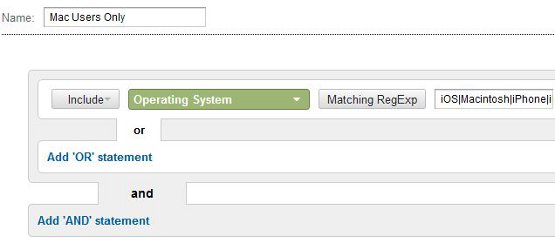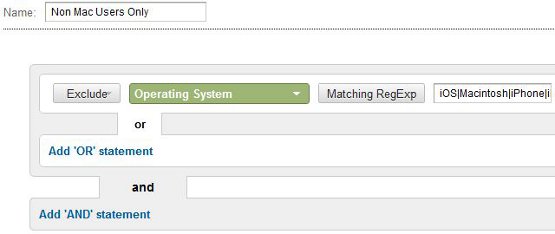Should You Advertise Higher Priced Goods To Mac Users?
 The WSJ recently had an article in which it identified that Orbitiz was showing higher priced hotels to Mac users, because Orbitz discovered that Mac users were spending up to “$20 to $30 more a night on hotels than their PC counterparts”. What in essense is going on is a type of price segmentation that is happening more and more every day as there is more data available for merchants to be able to discriminate with. This has happened for a while in other direct marketing industries where based on demographic data on a user they will show different offerings. The reason this is getting so much buzz now is because it is people are more interested in how their data is being used and because this looks like the beginning of another round in the culture battle of Macs vs. PCs. The Mac owners are saying that they do this because they feel you pay for what you get, and the PC owners are mocking the Mac owners as sheep who will buy anything with a higher priced tag.
The WSJ recently had an article in which it identified that Orbitiz was showing higher priced hotels to Mac users, because Orbitz discovered that Mac users were spending up to “$20 to $30 more a night on hotels than their PC counterparts”. What in essense is going on is a type of price segmentation that is happening more and more every day as there is more data available for merchants to be able to discriminate with. This has happened for a while in other direct marketing industries where based on demographic data on a user they will show different offerings. The reason this is getting so much buzz now is because it is people are more interested in how their data is being used and because this looks like the beginning of another round in the culture battle of Macs vs. PCs. The Mac owners are saying that they do this because they feel you pay for what you get, and the PC owners are mocking the Mac owners as sheep who will buy anything with a higher priced tag.
Learning To Segment Pricing
As a business owner you don’t care about the cultural battle; you want to find the way to maximize your profits while giving your customers what they want (Mac users want pricier hotels and PC users, according to Orbitz, want the cheaper option). So before you spend tons of money having your development team figure out a way to show your more expensive goods and services to Mac users, take a look at your own data.
How To Find Purchase Behavior Difference: Mac vs. PC
The wonderful part about today’s technology is that you have some really simple tools to help you figure this out for yourself. For this example we will use the most ubiquitous tool available: Google Analytics.
The first thing you have to do is to segment your audience between Mac Users and non Mac Users. Below is a screen shot of how I set up a custom segment in Google Analytics that combines all of my Mac users, both mobile and desktop users.
The full regex match (which is cut off in the above image) looks like this: iOS|Macintosh|iPhone|iPad|iPod
You can choose desktop only, but for this example we are going to compare all Apple OS’s against everything else, as you can see below. The only change is that we change “include” to “exclude” and then rename the segment.
So now that we have created our segments, we want to go ahead and see the differences in ecommerce statistics between the two groups. Below is what Google gave me for a given time range.
What Google is showing is that for this ecommerce site that the average order value for Mac Users is in fact higher than their non Mac counter parts. At this time I am thinking maybe there is something to this thing that Orbitz is doing. But, if you look closer you notice that the conversion rates between the two groups is very different. There are many tools online to determine if this is a significant difference in conversion rate. I used the linked UserEffect tool and got a statistically significant difference in conversion rate between the two groups. So Windows users for this site are more likely to convert, but this still doesn’t answer the question Orbitz asked which was do Mac users spend more on average. What we need to do is test the significance of that average order value number.
Average Order Value Statistical Significance
To do this you need to download the transaction data for both non Mac and Mac customers, because you need to be able to determine the variance in order value. You can download this data by going to conversions > ecommerce > transactions in Google Analytics. Once there, Google only lets you export 500 rows of transactions at one time, so to keep it simple I ensured my date ranges were under 500 transactions.
Once you get the order values for each set of customers in Excel you need to perform a t-test so that you can compare the means of the two groups. This t-test will give you the p-value that you will use to determine if the difference in average order values between the groups is significant. Yout formula in excel should look like the following:
=t.test(array of group 1, array of group 2,two-tailed distribution, two-sample equal variance homoscedastic)
This gave me a p-value of 0.15 for my example. Since this is greater than .05 or a 90% confidence interval we are going to think of the difference in the means here as a random event. So for this site there really isn’t a reason to pull an Orbitz and program the site to show Mac users more expensive products because the purchase patterns are essentially the same, but that might not be the case for your site. So check it out. However, running the analysis did teach me something which is that for the site in the example that we should make sure the website is functioning properly for Mac users to ensure that we aren’t losing conversions from an improperly functioning site.
Test Other Differences
Now that you have the experience to figure out if you should treat Mac users differently you can apply this same logic to compare other groups. You can ask questions like:
- Should you treat visitors differently from different parts of the country?
- Do new visitors or returning visitors spend more?
- Etc.





